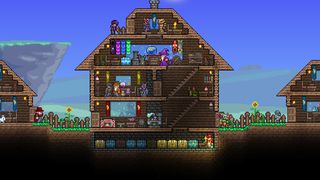How to build a house in Terraria
Lay the foundations of success with this handy Terraria house guide.

Looking for some Terraria house ideas? Well, you've got to know how to build one first. Games offer infinitely simpler worlds than our own. Building a house in the real world would take you a substantial amount of money or several years studying architecture (and in all likelihood, both). It’s far easier to build one digitally in Terraria, though there are still rules that must be followed. Otherwise, you’ll find yourself lonely when none of the NPCs move into the neighbourhood.
To get your Terraria town thriving, here's a breakdown of how to render your Terraria house designs in virtual bricks and mortar.
How to build a house in Terraria
Building a house in a game like Minecraft is easy enough. You put some blocks up and you’re done. You can even dig straight into the ground or hollow out the side of a hill. Terraria is different in that there are rules to follow. Houses must be at least 60 tiles in size, but no more than 750. This includes the walls you've built around the edges.

Terraria mods: The best fan-created tweaks
Terraria beginner's guide: Get started right
Terraria builds: The best for each class
Terraria creations: Ten incredible constructions
Terraria whips: Where to find the Summoner weapons
Walls must be made of blocks, doors, platforms or tall gates. The most common set up would be a door in either wall with blocks on top of it. Walls can also be shared by neighbouring houses, allowing you to construct little apartment complexes for your NPCs so they can 'live' in the same building.
Ceilings and floors, meanwhile, must be made of blocks, trapdoors, or platforms. The latter allow you to build a block of houses that can be easily navigated. It’s important to remember that NPCs and enemies can’t use trapdoors, which may either help or hinder you depending on how much you like your NPCs. Although you can use platforms yourself, at least one solid block must be available for an NPC to stand on. This should coincide with a 2-by-3 area of clear tiles, too. Weirdly, this area can still include both flat items and comfort items.
On the subject of which, each house must contain one comfort item, one flat item, and one light source. The easiest way to meet all three conditions is by building a chair, a work bench, and a torch, then placing them in the house. Finally, each house must have background walls. While you can have gaps in these, it’s better to fill them and thereby prevent enemies spawning there.
This may sound like a lot, but it’s easy enough if you keep things simple. If you want your houses to be as efficient as possible, then they should:
The biggest gaming news, reviews and hardware deals
Keep up to date with the most important stories and the best deals, as picked by the PC Gamer team.
- Be 6 tiles high by 10 tiles long. This is because you can jump 6 tiles, which makes it easy to build up as well as out.
- Have a door on each wall at the bottom.
- Have background walls.
- Contain a torch, a wooden table or work bench, and a chair.
- Be built from dirt or wood, the easiest materials to use.
If you’ve managed all that, you should be able to assign an NPC to the house. You can also use the housing menu to check whether or not the house is valid. If it isn't, ensure to check all of the above criteria. It’s generally best to stack houses on top of each other or place them next to each other. This makes meeting NPCs easier and requires fewer materials, as they can all share walls and ceilings.
Most Popular


